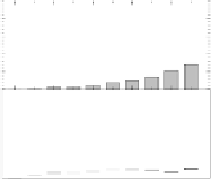Information Technology Reference
In-Depth Information
The graph will display the results (though you can't
really see the first point). Note that the first level of
damage is 0 percent (i.e., an intact network), and so is
not very interesting. However, the next time the net-
work display is updated, you should notice that several
units from the
OS_Hid
layer are missing — this reflects
the partial damage, which will increase in severity next
time through. You should notice that the left graph be-
gins to reflect the presence of visual errors on both con-
crete and abstract words by around 30 percent damage
levels (X axis value of 3).
After one iteration up through 90 percent dam-
age levels (X axis value of 9 in the left graph), the
lesion sequence will proceed to the next layer as
shownintable10.4(i.e.,the
SP_Hid
layer this time),
and so on until all the lesion types have been per-
formed. When complete, a picture of the damage ef-
fects at the 90 percent level will be evident in the
LesAmtBatch_3_GraphLog
on the right.
Unfortunately, you probably will not be able to make
much sense of the results you obtain in your graphs be-
cause of the random nature of the lesion — you would
need to average over many different instances of each
lesion type to get reliable statistics about the expected
types of errors from each lesion type. The process you
just ran was configured to just run one instance of each
lesion type, but it can be run with more repetitions (us-
ing the
SetN
function in the control panel). We ran
the lesion battery with 25 repetitions for each lesion,
and produced some easier-to-read graphs of the main
results.
Figure 10.10 shows the results for the different le-
sions of the semantic pathway with an intact direct path-
way (i.e., lesion types 0 and 1), with concrete and ab-
stract plotted separately. Like the network with the
completely lesioned semantic pathway, this network
makes almost exclusively visual errors, which is gener-
ally consistent with surface dyslexia, as expected. It is
somewhat counterintuitive that semantic errors are not
made when lesioning the semantic pathway, but remem-
ber that the intact direct pathway provides orthographic
input directly to the phonological pathway. This in-
put generally constrains the phonological output to be
something related to the orthographic input, and it pre-
vents any visually unrelated semantic errors from creep-
Visual
Vis + Sem
Semantic
Blend
Other
Concrete
Abstract
SP_Hid
SP_Hid
20
15
10
5
0
OS_Hid
OS_Hid
20
15
10
5
0
0.0
0.2 0.4 0.6 0.8
Lesion Proportion
0.0
0.2 0.4 0.6 0.8
Lesion Proportion
Figure 10.10:
Error types for semantic pathway lesions with
an intact direct pathway.
N =25
for each point.
ing in. In other words, any tendency toward semantic
errors due to damage to the semantic pathway is pre-
empted by the direct orthographic input. We will see
that when this direct input is removed, semantic errors
are indeed made.
Interestingly, lesions of the semantic layer itself pro-
duce more errors for
concrete
versus abstract words —
this is (also) somewhat counterintuitive. This finding
can be understood by considering the division of labor
that develops when the semantic system is much bet-
ter able to process concrete words compared with ab-
stract ones. The direct pathway will then have to take up
more of the responsibility for processing abstract words.
The effects of damage can be understood in two com-
plementary ways. From the perspective of dependence
on the damaged semantic pathway, concrete words suf-
fer more because they depend more on this damaged
pathway. From the perspective of dependence on the
intact direct pathway, abstract words suffer less because
they depend more on this intact pathway. This result
shows that there can be general effects of semantic vari-
ables even though the network does not make specific
confusions among words with similar semantics (i.e.,
semantic errors). However, we are not aware of data
from people with surface dyslexia that would substanti-
ate the existence of this effect in humans, and it is pos-
sible that other factors such as frequency and regularity
would swamp this effect.




























































Search WWH ::

Custom Search